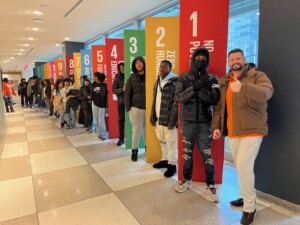Making Something of National Week of Making

“Makers and builders and doers – of all ages and backgrounds – have pushed our country forward, developing creative solutions to important challenges and proving that ordinary Americans are capable of achieving the extraordinary when they have access to the resources they need. During National Week of Making, we celebrate the tinkerers and dreamers whose talent and drive have brought new ideas to life, and we recommit to cultivating the next generation of problem solvers,” said President Obama in his proclamation kicking off the National Week of Making.
A White House celebration kicked off a National Maker Faire, a showcase of makers, tinkerers, experimenters across the fields of science, engineering, art, and craft, “Curious people who enjoy learning and love sharing what they can do.”
One of those people is Andrew Coy. We opened our latest book, Smart Cities, with his compelling maker story:
Teacher Andrew Coy left what was supposed to be the most innovative high school in Baltimore frustrated with the pace of change and the inability to create current and compelling learning experiences. With persistence, he gained control of a recreation center abandoned by the city and created the Digital Harbor Foundation. The rec-center-turned-tech-center hosts before, during and after school learning experiences. With the chamber of commerce, county, investors and other Edupreneurs, Andrew sparked a new conversation and created the initiative EdTech.MD to promote innovations in learning, support convening, and grow human and financial capital. This wave of Baltimore entrepreneurship builds on 20 years of national EdTech leadership from companies including Connections Education and Sylvan Learning, as well as investors like New Markets Venture Partners, but until recently there were limited links to local schools and teachers. The explosion of EdTech apps, investments and events in this decade is finally making the connection with teachers. In June 2014, only 18 months after opening, Coy and Digital Harbor Foundation launched a national technical assistance center to help other communities replicate the nonprofit’s innovative maker programs.
During his White House visit, Coy kicked off Rec2Tech.org, an initiative to replicate his success at turning surplus property into a maker hub.

The initiative offers a, “New vision for how communities can come together to provide real pathways from classroom to career for today’s youth.” Coy argues that young people need the freedom to explore interests and the time and space to do so. In a press release, Coy said:
“The economy desperately needs more technologists and youth of all ages are interested in technology. The Rec2Tech model re-imagines how technology education can reach even more youth. We are excited to assist other cities in expanding technology learning opportunities.”
Three more cool maker examples we’ve featured recently:
- For a visual overview, see The Makings of a Makerspace: Three Examples
- Ever imagine wearable craft electronics? Check out blink blink Designs Educational Tech Kits with Girls, for Girls
- Ever think of music as maker craft? see Music Builds Maker Mindsets: The Power of the Performing Arts
Imagination. A maker mindset starts with imagination. The Imagination Foundation (where I’m a director) is expanding access to mind expanding experiences by growing 100 more Imagination Chapters. Maker spaces that have a low floor and work well for under resourced communities, require little training.
The Chapters program grew out of the Global Cardboard Challenge, winner of the LEGO’s Re-imagine Learning Challenge as, “One of the most innovative, impactful and sustainable projects aimed at transforming the way the world learns.”
For more, see:






0 Comments
Leave a Comment
Your email address will not be published. All fields are required.